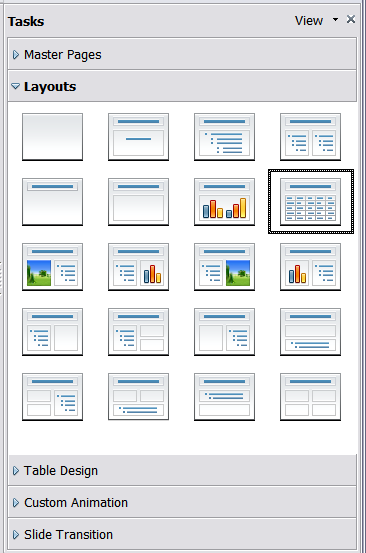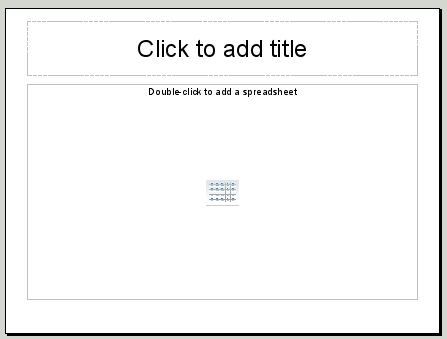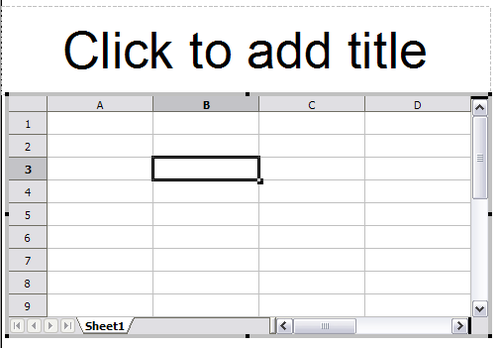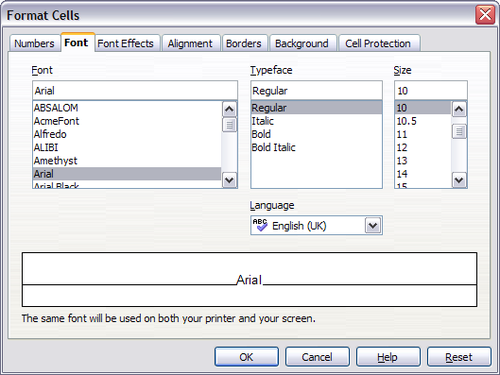Using spreadsheets in Impress
A spreadsheet embedded in Impress includes most of the functionality of a spreadsheet in Calc and is therefore capable of performing complex calculations and data analysis. However, if you need to analyze your data or apply formulas, these operations are best performed in a Calc spreadsheet and the results displayed in an embedded Impress spreadsheet.
Many people also use spreadsheets in Impress for creating complex tables or presenting data in a tabular format. However, for this purpose you may find the new Table Design feature (described in Chapter 3) more suitable.
Inserting a spreadsheet
To add a spreadsheet to a slide, select the corresponding layout in the list of predefined layouts in the Tasks pane, as shown below.
This inserts a placeholder for a spreadsheet in the center of a slide, as shown below.
Double-click inside the frame to enter the edit mode, shown below, where you can insert data and modify the formatting of the spreadsheet. See Entering data and Formatting spreadsheet cells.
It is also possible to insert a spreadsheet as an OLE object as described in [[Inserting other objects.
When editing a spreadsheet, some of the contents of the main menu bar change, as does the Formatting toolbar, to show entries and tools that support working with the spreadsheet.
One of the most important changes is the presence of the Formula toolbar, just below the Formatting toolbar. The Formula toolbar contains (from left to right):
- The active cell reference or the name of the selected range
- The Formula Wizard button
- The Sum and Formula buttons or the Cancel and Accept buttons (depending on the contents of the cell)
- A long edit box to enter or review the contents of a cell
If you are familiar with Calc, you will immediately recognize the tools and the menu items since they are much the same.
Resizing and moving a spreadsheet
When resizing or moving a spreadsheet, ignore the first row and the first column (easily recognizable because of their light gray background) and the horizontal and vertical scroll bars). They are only used for editing purposes and will not be included in the visible area of the spreadsheet on the slide.
To resize the area occupied by the spreadsheet:
- Double-click to enter the edit mode, if it is not already active. Notice the black handles found in the gray border surrounding the spreadsheet.
- Move the mouse over one of the handles. The cursor changes shape to give a visual representation of the effects applied to the area.
- Click and hold the left mouse button and drag the handle. The corner handles resize the two sides forming the corner simultaneously, while the handles in the middle of the sides modify one dimension at a time.
You can move the spreadsheet (change its position within the slide) whether in edit mode or not. In both cases:
- Move the mouse over the border until the cursor changes shape.
- Click and hold the left mouse button and drag the spreadsheet to the desired position.
- Release the mouse button.
When selected but not in edit mode (green handles), the spreadsheet object is treated like any other object, therefore resizing it results in changing the scale rather than the spreadsheet area. This is not recommended, because it may distort the fonts and picture shapes.
Moving around the spreadsheet
How a spreadsheet is organized
A spreadsheet consists normally of multiple tables which in turn contain cells. However, in Impress only one of these tables can be shown at any given time on a slide.
The default for a spreadsheet embedded in Impress is one single table called Sheet 1. The name of the table is shown at the bottom of the spreadsheet area (see Figure 3).
If required, you can add other sheets. To do that:
- Right-click on the bottom area near the existing tab.
- Select Insert > Sheet from the pop-up menu.
Just like in Calc, you can rename a sheet or move it to a different position using the same pop-up menu or the Insert menu on the main menu bar.
| Even if you have many sheets in your embedded spreadsheet, only one sheet—the one which is active when leaving the spreadsheet edit mode—is shown on the slide. |
Each of the sheets is further organized into cells. Cells are the elementary unit of the spreadsheet. They are identified by a row number (shown on the left hand side on gray background) and a column letter (shown in the upper part again on gray background). For example, the top left cell is identified as A1, while the third cell in the second row is C2. All data, whether text or numbers, is input in a cell.
Moving the cursor to a cell
To move around the spreadsheet and select the cell which has the focus, you can:
- Use the arrow keys.
- Left-click with the mouse on the desired cell.
- Use the combinations Enter and Shift+Enter to move one cell down or one cell up respectively; Tab key and Shift+Tab key to move one cell to the right or to the left respectively.
Other keyboard shortcuts are available to move quickly to certain cells of the spreadsheet. Refer to Chapter 5 (Getting Started with Calc) in the Getting Started guide for further information.
Entering data
Keyboard input is received by the active cell, identified by a thick black border. The cell reference (or coordinates) is also shown on the left hand end of the formula bar.
To insert data, first select the cell to make it active, then type in it. Note that the input is also added to the main part of the formula bar where it may be easier to read.
Impress will try to automatically recognize the type of contents (text, number, date, time, and so on) of a cell and apply default formatting to it. Note how the formula bar icons change according to the type of input, displaying Accept and Reject buttons (![]() ) whenever the input is not a formula. Use the green Accept button to accept the input made in a cell or simply select a different cell. In case Impress wrongly recognized the type of input, you can change it using the toolbar, or from Format > Cells in the main menu bar.
) whenever the input is not a formula. Use the green Accept button to accept the input made in a cell or simply select a different cell. In case Impress wrongly recognized the type of input, you can change it using the toolbar, or from Format > Cells in the main menu bar.
Formatting spreadsheet cells
Normally, for the purpose of a presentation, it may be necessary to increase considerably the size of the font as well as matching it to the style used in the presentation.
The fastest and most flexible way to format the embedded spreadsheet is to make use of styles. When working on an embedded spreadsheet, you can access the cell styles created in Calc and use them. However, the best approach is to create specific cell styles for presentation spreadsheets, as the Calc cell styles are likely to be unsuitable when working within Impress.
To apply a style (or indeed manual formatting of the cell attributes) to a cell or group of cells simultaneously, first select the range to which the changes will apply. A range consists of one or more cells, normally forming a rectagular area. A selected range consisting of more than one cell can be recognized easily because all its cells except the active one have a black background. To select a multiple-cell range:
- Click on the first cell belonging to the range (either the left top cell or the right bottom cell of the rectangular area).
- Keep the left mouse button pressed and move the mouse to the opposite corner of the rectangular area which will form the selected range.
- Release the mouse button.
To add further cells to the selection, hold down the Control key and repeat the steps 1 to 3 above.
Some shortcuts are very useful to speed up the selection:
- To select the whole visible sheet, click at the intersection between the rows indexes and the column indexes, or press Control+A.
- To select a column, click on the column index at the top of the spreadsheet.
- To select a row, click on the row index on the left hand side of the spreadsheet.
Once the range is selected, you can modify the formatting, such as font size, alignment (including vertical alignment), font color, number formats, borders, background and so on. To access these settings, choose Format > Cells from the main menu bar (or right-click and choose Format Cells from the pop-up menu). This command opens the dialog box shown below.
If the text does not fit the width of the cell, you can increase the width by hovering the mouse over the line separating two columns and, when the mouse cursor changes shape, clicking the left button and dragging the separating line to the new position. A similar procedure can be used to modify the height of a cell (or group of cells).
To insert rows and columns in a spreadsheet, use the Format menu or right-click on the row and column headers and select the appropriate option from the pop‑up menu. To merge multiple cells, select the cells to be merged and select Format > Merge cells from the main menu bar. To de-merge a group of cells, select the group and again Format > Merge Cells (which will now have a checkmark next to it).
When you are satisfied with the formatting and the appearance of the table, exit the edit mode by clicking outside the spreadsheet area. Note that Impress will display exactly the section of the spreadsheet which was on the screen before leaving the edit mode. This allows you to hide additional data from the view, but it may cause the apparent loss of rows and columns. Therefore, take care that the desired part of the spreadsheet is showing on the screen before leaving the edit mode.
| Content on this page is licensed under the Creative Common Attribution 3.0 license (CC-BY). |




